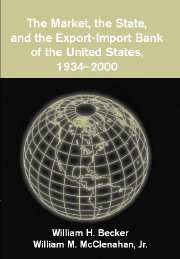Book contents
- Frontmatter
- Contents
- Preface and Acknowledgments
- Introduction
- 1 Setting a Flexible Course: The Export-Import Bank, 1934–1939
- 2 World War and Its Aftermath
- 3 Cold War and the Needs of a New Era, 1948–1961
- 4 Becoming “Two Institutions”
- 5 New Mandates and New Limits
- 6 Turmoil and Turning Points
- 7 A New Era and Its Challenges, the 1990s
- Epilogue
- Appendix A Board of Directors
- Appendix B Summary of Authorizations
- Appendix C Number of Authorizations
- Appendix D Charges Against Statutory Limitations on Total Activity
- Index
1 - Setting a Flexible Course: The Export-Import Bank, 1934–1939
Published online by Cambridge University Press: 13 July 2009
- Frontmatter
- Contents
- Preface and Acknowledgments
- Introduction
- 1 Setting a Flexible Course: The Export-Import Bank, 1934–1939
- 2 World War and Its Aftermath
- 3 Cold War and the Needs of a New Era, 1948–1961
- 4 Becoming “Two Institutions”
- 5 New Mandates and New Limits
- 6 Turmoil and Turning Points
- 7 A New Era and Its Challenges, the 1990s
- Epilogue
- Appendix A Board of Directors
- Appendix B Summary of Authorizations
- Appendix C Number of Authorizations
- Appendix D Charges Against Statutory Limitations on Total Activity
- Index
Summary
INTRODUCTION
Franklin D. Roosevelt established the first Export-Import Bank of Washington in February 1934 to serve his foreign policy and promote economic recovery in the United States. He wanted the Bank to help normalize relations with the Soviet Union. The effort bogged down and failed following protracted discussions over previously unpaid Soviet debts. Another diplomatic objective – improving relations with a turbulent Cuba – prompted the Roosevelt administration to establish the second Export-Import Bank of Washington a few weeks later in March 1934. In June 1935, after officials determined that no business would be done with the Soviet Union, the two banks merged to form one Export-Import Bank of Washington (Ex-Im).
From the first, organized groups of American exporters and bankers supported the new government banking institutions. Exporters needed the Bank's services during the 1930s because of depressed conditions and the rapid deterioration of international trade and finance. Officials of the Roosevelt administration were sensitive to their needs and saw the Banks as contributing to economic recovery.
In its first decade, the Bank struggled to define its own mission. Ex-Im officials created an official dialogue with organized export and banker groups as the Bank developed its operating policies and procedures. Increasingly in the 1930s, Bank officials and staff defined the Ex-Im's role as promoting American export of agricultural and manufactured goods. But there were constraints on what the Bank could do.
- Type
- Chapter
- Information
- Publisher: Cambridge University PressPrint publication year: 2003



